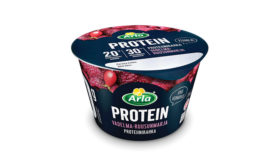Home » Keywords: » high-protein diet
Items Tagged with 'high-protein diet'
ARTICLES
There is plenty of room in the growing protein category for dairy-based and plant-based sources. In fact, there are good reasons to formulate with a blend of dairy and plant proteins.
Read More
Use dairy’s total nutrition to meet protein needs
Research makes the case for why dairy should be the protein of choice. Meanwhile, new products containing whey protein are on the rise.
August 4, 2017
Dairy protein along with exercise leads to healthy aging
Aging muscles need up to 40 grams of protein at each meal. Look to the breakfast table when developing new concepts because the first meal of the day often lacks sufficient protein.
June 2, 2017
Protein benefits everyone, from children to seniors
It’s not just elite athletes who need protein. The ingredient holds benefits for everyone, from children to seniors and from recreational athletes to those seeking to lose weight.
January 30, 2017
Stay ahead of the curve. Unlock a dose of cutting-edge insights.
Receive our premium content directly to your inbox.
SIGN-UP TODAYCopyright ©2025. All Rights Reserved BNP Media.
Design, CMS, Hosting & Web Development :: ePublishing






